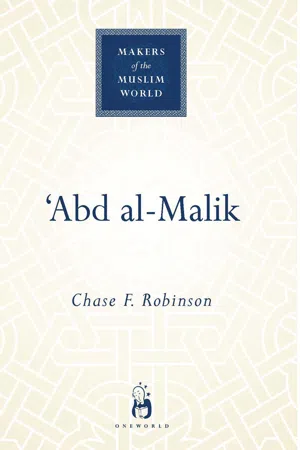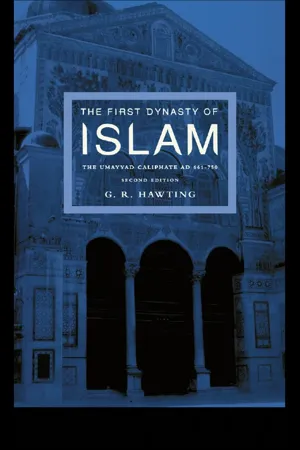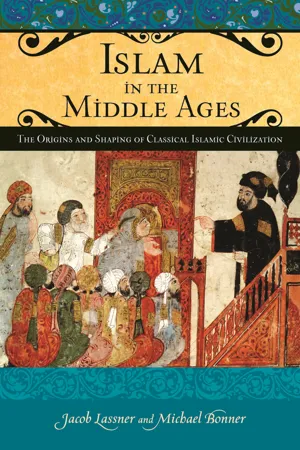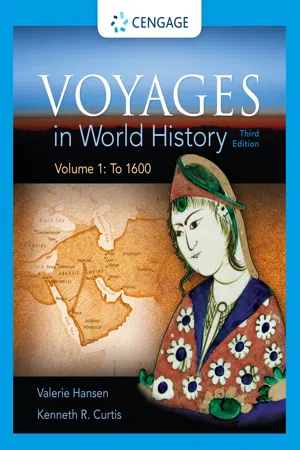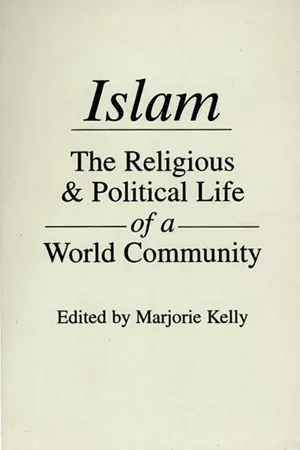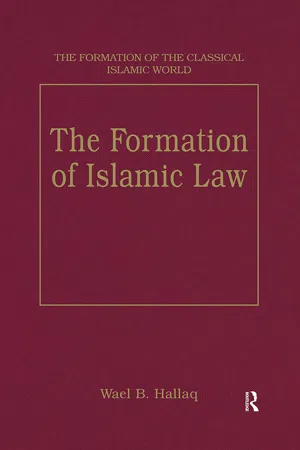History
Abd al-Malik
Abd al-Malik was the fifth Umayyad caliph who ruled from 685 to 705 AD. He is known for centralizing the administration of the Islamic empire, standardizing coinage, and constructing the Dome of the Rock in Jerusalem. Abd al-Malik's reign marked a significant shift in the governance and cultural identity of the Islamic world.
Written by Perlego with AI-assistance
Related key terms
1 of 5
6 Key excerpts on "Abd al-Malik"
- eBook - ePub
- Chase F. Robinson(Author)
- 2012(Publication Date)
- Oneworld Academic(Publisher)
Was this the case? Al-Hajjaj’s pronouncement is striking because most Muslims from the ninth and tenth centuries would come to reject circumambulation around all buildings except the Ka‘ba (and explicitly proscribe it around the Prophet’s grave), just as they would reject circumambulation of individuals. It is true that the report may have been put into circulation by an opponent of the Marwanids, with a view to attaching opprobrium to both governor and caliph. Of opponents they certainly had plenty. According to a history written by a North African sectarian, ‘Abd al-Malik is a tyrant and al-Hajjaj accursed, and a fifteenth-century historian from Egypt catalogues the manifold vices of the Umayyads, including al-Hajjaj’s view, expounded from none other than a mosque pulpit, that ‘Abd al-Malik was superior to the Prophet. Both also take the Marwanids to task for changing the time of prayer. It is unlikely, however, that our circumambulation account can be dismissed on the grounds of such hostility, for a polemicist would have had al-Hajjaj dissuade the faithful from discharging a widely accepted and revered practice – circling the Ka‘ba – rather than an aberrant one, such as circling the Prophet’s house. We should accordingly follow the principle introduced above, according to which discordant reports have a special claim on our trust, especially if they fit a broader pattern. And this one does fit a broader pattern. According to a letter written to ‘Abd al-Malik and credited to al-Hajjaj, God held the caliph in higher regard than He did the Prophet Muhammad himself.It is through the rains summoned by the caliph that the community is nurtured, as it is in the shade he throws that it finds shelter. When ‘Abd al-Malik makes his case against Ibn al-Zubayr, he makes a case for himself as “God’s shadow on earth” (al-Baladhuri, 33). And it is by one’s imam that believers knew correct belief and praxis. As the poet, al-Farazdaq, put it, “You are to this religion like the direction of prayer, by which people are guided from going astray” (Kister, ‘Social and religious concepts’, 106). We have already seen that Farazdaq describes the caliph as God’s instrument who guides His flock.What ‘Abd al-Malik and other Umayyad caliphs promised to deliver to those who recognized and embraced them as imams (religious leaders) was nothing less than salvation. “He who dies having no religious leader will die the death of a pre-Islamic pagan,” as an early tradition puts it (such a death lands one in Hell). It is precisely because the stakes were so high that the controversies and battles of the Second Civil War were so fierce. “What do you witness for Ibn Zubayr?”, a commander asked of the people of the province of Jordan: “We bear witness that Ibn al-Zubayr is a hypocrite [a term used for those who deny Islam] and those of the people of Harrah (the site of a battle) who were killed are in Hell.” The commander himself held that “if the religion of Yazid b. Mu‘awiya was truth while he was alive at that time, it is still so today and his party [shi‘a - eBook - ePub
The First Dynasty of Islam
The Umayyad Caliphate AD 661-750
- G. R Hawting(Author)
- 2002(Publication Date)
- Routledge(Publisher)
Chapter 5 ‘Abd al-Malik and al-HajjajAfter Marwan’s accession to the caliphate in 684 all of the remainder of the Umayyad caliphs were descended directly from him. It is remarkable that his son ‘Abd al-Malik (caliph 685–705) was himself succeeded in the caliphate by no fewer than four of his own sons, the succession of the brothers continuing down until 743 and being interrupted only by the brief caliphate of their cousin ‘Umar b. ‘Abd al-‘Aziz (717–20).1 ‘Abd al-Malik’s immediate successor was his eldest son al-Walid I (705–15) and his rule seems hardly differentiated from that of his father, for, almost from the time when the civil war ended until shortly before the death of al-Walid, the dominant figure in the sources is the governor of Iraq and viceroy of the east al-Hajjaj (governor 694–714). Like his predecessor Ziyad, we tend to hear more about him than about the caliphs in Syria and he thus serves to give a unity to the period of ‘Abd al-Malik and al-Walid. This period, although not without its problems for the government, was in some ways the high point of Umayyad power, witnessing significant territorial advances both in the east and the west and the emergence of a more marked Arabic and Islamic character in the state’s public face. Before discussing the period following the civil war, however, there are some developments in the earlier part of ‘Abd al-Malik’s caliphate which need to be noted.First, the grip of the Marwanids on the caliphate was tightened. At the meeting which discussed the future of the caliphate before Marj Rahit in 684 the Marwanids had not been the only branch of the Umayyad family in contention, and acceptance of Marwan seems to have been secured only at the price of guarantees regarding the future right of succession of some of the other contenders. The claims of the surviving members of the family of Yazid b. Mu‘awiya may have been sidestepped by Marwan’s marriage to Yazid’s widow Fakhita. Indeed some sources say that Marwan’s refusal to honour the promises he had made about the succession of Khalid the son of Yazid led Fakhita to poison her new husband. A stronger rival of Marwan was ‘Amr b. Sa‘id al-Ashdaq of another branch of the Umayyad family, whose seniority was indicated by the fact that he had been governor of Medina for a while under Yazid. When ‘Abd al-Malik succeeded Marwan, ‘Amr felt that the guarantees made before Marj Rahit had not been honoured, and, in 689–90, taking advantage of the absence of ‘Abd al-Malik in the field against the Zubayrids, he revolted and seized Damascus. ‘Abd al-Malik had to abandon his expedition and on his return to Damascus he had ‘Amr b. Sa‘id killed, apparently after promising him a safe conduct.2 - eBook - PDF
Islam in the Middle Ages
The Origins and Shaping of Classical Islamic Civilization
- Jacob Lassner, Michael Bonner(Authors)
- 2009(Publication Date)
- Praeger(Publisher)
The salient features of that story are revealed in the pages that follow. T H E S P L I T B E T W E E N T H E H A S H I M I T E S 133 9 Centralizing Power: The Rise of a Universal Islamic Empire More surprising than the Abbasids’ ability to co-opt the revolution that brought down the house of Umayyah and beat back the challenge of their more illustrious ‘Alid cousins was the manner in which the second Abbasid caliph, Abu Ja‘far al-Mansur, established the foundations of a dynastic order whose rule was formally recognized from Central Asia in the east to the most distant reaches of North Africa in the west. One could easily make the case that al-Mansur was the architect who shaped Abbasid rule and with that laid the foundations of a more universal and cosmopolitan Islamic community than ever existed before. Indeed, one might wish to argue that the caliph and his progeny were instrumental in laying the groundwork for so much of what we now recognize as medi- eval Islamic civilization. How is it then that the rather nondescript older brother of al-Saffah, a figure who played no significant role before or immediately after the outbreak of the general revolt against the Umayyads, took command of the family and established the foundations of a dynastic order that would keep the Abbasid house on a more or less even keel despite internal and external stresses and strains? With the formal recognition of al-Saffah’s caliphate, the politics of the Abbasid family was exposed to public view for the first time. Numerous relatives, all more or less the same age, took command of the ummah, a task for which they had prepared for several decades. Among the inner circle of the Abbasids were several of the new caliph’s paternal uncles (‘umumah), his nephew ‘Isa ibn Musa, and his elder brother Abu Ja‘far. Once in the open, the caliph’s kin were dispatched to take control of the functioning government bureaucracy as well as various Khurasani regi- ments that had entered Iraq. - eBook - PDF
- Valerie Hansen, Ken Curtis(Authors)
- 2016(Publication Date)
- Cengage Learning EMEA(Publisher)
Others could be king, but the Abbasids had a unique claim to being caliph. This chapter will examine the history of Islam, from the first revelations received by Muhammad to the final collapse of the Abbasid empire in 1258. Muhammad (ca. 570–632) Believed by Muslims to be the last prophet who received God’s revela-tions directly from the angel Gabriel. The first leader of the Muslim community. FOCUS QUESTIONS ❯ Who was the prophet Muhammad, and what were his main teachings? ❯ Between Muhammad’s death in 632 and the founding of the Abbasid caliphate in 750, what were the different ways that the Islamic commu-nity chose the new caliph? ❯ Which economic, political, and social forces held the many peoples and territories of the Abbasid caliphate together? ❯ After the fragmentation of the Abbasid empire in 945, which cultural practices, technologies, and customs held Islamic believers in different regions together? The Origins of Islam and the First Caliphs, 610–750 M uhammad began to preach sometime around 613 and won a large following among the residents of the Arabian peninsula before his death in 632. The man who succeeded to the leadership of the Islamic religious community was called the caliph (KAY-lif), literally “successor.” The caliph exercised political authority because the Muslim religious community was also a state, complete with its own government and a powerful army that conquered many neighboring regions. The first four caliphs were chosen from different clans on the basis of their ties to Muhammad, but after 661 all the caliphs came from a single clan, or dynasty, the Umayyads, who governed until 750. Muhammad was born into a family of merchants sometime around 570 in Mecca, a trading community in the Arabian peninsula far from any major urban center. At the time of his birth, the two major powers of the Mediterranean world were the Byzantine empire (see Chapter 10) and the Sasanian empire of the Persians (see Chapter 6). - eBook - PDF
Islam
The Religious and Political Life of a World Community
- Gustave E. Von Grunebaum(Author)
- 1984(Publication Date)
- Praeger(Publisher)
How successful the Umayyad enterprise was in all its aspects is transparent to anyone, Muslim or not, who has ever stood on the Mount of Olives and gazed down upon the Noble Sanctuary of Jerusalem. To some modern eyes—those of Westerners, for example, or some Arab nationalists—the Umayyad rule of the Dar al-Islam from 661 to 750 C.E. appears as a golden age. To many of their Muslim contemporaries, the Umayyads were worldly tyrants and nepotists, altogether too kingly and too secular to govern a commu- nity whose essential, and perhaps sole, bond was a shared submis- sion to the will of God. In 750 the dynasty was overthrown, and rule passed to the Abbasids, who held the caliphal office first in Baghdad and then in Cairo until it was assumed by the Ottoman Turks in the sixteenth century. Unlike the Umayyads, who made Francis E. Peters . 79 little effort in that direction, the Abbasids were successful in cloak- ing themselves with at least the appearance of temporal and spiritual Islamic legitimacy. Jesus said he had come to bring not peace but the sword. Muhammad promised neither but demanded, in God's name, sub- mission to God's will. But promised or not, intended or not, the Prophet's followers brought peace: not always peace among them- selves, surely—Sunnis and Shi'is battled savagely on occasion—but on a larger, international scale. The conquests destroyed little; what they did suppress were imperial rivalries and sectarian blood- letting among the newly subjected population. The Muslims toler- ated Christianity but they disestablished it; henceforward Christian life and liturgy, its endowments, politics, and theology, would be a private and not a public affair. By an exquisite irony, Islam reduced the status of Christians to that which the Christians had earlier thrust upon the Jews, though with one difference. - eBook - PDF
- Wael B. Hallaq(Author)
- 2016(Publication Date)
- Routledge(Publisher)
A difference of function between the caliphs and the 'ulama' in and by itself does not necessarily signify a separation of state and religion; nor even are the functions all too rigidly separated. The caliph too exercises his ijtihiid after all, and with the 'ulama' establishing the proofs of religion, as the foregoing state-ment has it, he too dispels the rebels' doubts to bring them back to the community's fold. Some of the other juristic texts we have analyzed earlier make clear that it is not only the doubts of the rebels but also legal and administrative matters obscure to his governor and qatjf that are to be referred to him. The caliph does not define the law; but, even after the Mi(tna, he remains part of the religious circles in which it is interpreted. here were not espoused by him, but even if that turns out to be the case, they would still reflect the thinking of l:fanbali circles and be significant for that reason. 123 God's Caliph, 109-110. GENERAL INDEX In this index, the Arabic definite article ( al-) at the beginning of an entry, the transliteration symbols for the Arabic letters hamza and 'ayn, and the distinction between different letters transliterated by the same Latin charac-ter (e.g. d and if) are ignored for purposes of alphabetization. Inconsistencies in spelling and transliteration in the text reflect the varying conventions of the publications in which the articles originally appeared. 'Abbasids and Malikls 357-58; and qii¢fs 180, 185-86, 188, 190, 193-95, 197-98, 199, 201, 205; and role and function of caliphs 367-402; and Umayyads 202, 391 'Abd Allah ibn ai-'Abbas 45, 100, 212-13 n. 3, 321, 323 'AbdAllah ibn Abl Naji):J 161, 170, 173 'AbdAllah ibn Abl Zakarlya' 162 'Abd Allah ibn AI) mad ibn Banbal 334 'AbdAllah ibn 'Awn ibn Artaban 165,171 n. 70 'Abd Allah ibn Iba<;l 220 'Abd Allah ibn Ja'far 321 'Abd Allah ibn Lahl'a 163, 389 'Abd Allah ibn Malik ai-J1shan1163 'Abd Allah ibn ai-Mubarak ai-Marwazl 166, 172 n.
Index pages curate the most relevant extracts from our library of academic textbooks. They’ve been created using an in-house natural language model (NLM), each adding context and meaning to key research topics.
